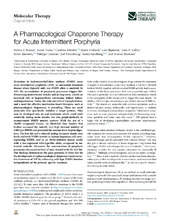| dc.contributor.author | Bustad, Helene J. | en_US |
| dc.contributor.author | Toska, Karen | en_US |
| dc.contributor.author | Schmitt, Caroline | en_US |
| dc.contributor.author | Vorland, Marta | en_US |
| dc.contributor.author | Skjærven, Lars | en_US |
| dc.contributor.author | Kallio, Juha Pekka | en_US |
| dc.contributor.author | Simonin, Sylvie | en_US |
| dc.contributor.author | Lettéron, Philippe | en_US |
| dc.contributor.author | Underhaug, Jarl | en_US |
| dc.contributor.author | Sandberg, Sverre | en_US |
| dc.contributor.author | Martinez, Aurora | en_US |
| dc.date.accessioned | 2020-04-19T11:29:28Z | |
| dc.date.available | 2020-04-19T11:29:28Z | |
| dc.date.issued | 2019-12-03 | |
| dc.Published | Bustad HJ, Toska K, Schmitt C, Vorland M, Skjærven L, Kallio J, Simonin, Lettéron P, Underhaug J, Sandberg S, Martinez A. A Pharmacological Chaperone Therapy for Acute Intermittent Porphyria. Molecular Therapy. 2019 | eng |
| dc.identifier.issn | 1525-0024 | |
| dc.identifier.issn | 1525-0016 | |
| dc.identifier.uri | https://hdl.handle.net/1956/21929 | |
| dc.description.abstract | Mutations in hydroxymethylbilane synthase (HMBS) cause acute intermittent porphyria (AIP), an autosomal dominant disease where typically only one HMBS allele is mutated. In AIP, the accumulation of porphyrin precursors triggers life-threatening neurovisceral attacks and at long-term, entails an increased risk of hepatocellular carcinoma, kidney failure, and hypertension. Today, the only cure is liver transplantation, and a need for effective mechanism-based therapies, such as pharmacological chaperones, is prevailing. These are small molecules that specifically stabilize a target protein. They may be developed into an oral treatment, which could work curatively during acute attacks, but also prophylactically in asymptomatic HMBS mutant carriers. With the use of a 10,000 compound library, we identified four binders that further increased the initially very high thermal stability of wild-type HMBS and protected the enzyme from trypsin digestion. The best hit and a selected analog increased steady-state levels and total HMBS activity in human hepatoma cells overexpressing HMBS, and in an Hmbs-deficient mouse model with a low-expressed wild-type-like allele, compared to untreated controls. Moreover, the concentration of porphyrin precursors decreased in liver of mice treated with the best hit. Our findings demonstrate the great potential of these hits for the development of a pharmacological chaperone-based corrective treatment of AIP by enhancing wild-type HMBS function independently of the patients’ specific mutation. | en_US |
| dc.language.iso | eng | eng |
| dc.publisher | Elsevier | eng |
| dc.relation.uri | https://www.sciencedirect.com/science/article/pii/S1525001619305064?via%3Dihub#! | |
| dc.rights | Attribution CC BY-NC-ND 4.0 | eng |
| dc.rights.uri | http://creativecommons.org/licenses/by-nc-nd/4.0/ | eng |
| dc.title | A Pharmacological Chaperone Therapy for Acute Intermittent Porphyria | en_US |
| dc.type | Peer reviewed | |
| dc.type | Journal article | |
| dc.date.updated | 2020-02-05T20:49:59Z | |
| dc.description.version | publishedVersion | en_US |
| dc.rights.holder | Copyright 2019 The Author(s) | |
| dc.identifier.doi | https://doi.org/10.1016/j.ymthe.2019.11.010 | |
| dc.identifier.cristin | 1757006 | |
| dc.source.journal | Molecular Therapy | |
| dc.relation.project | Helse Vest RHF: 912246 | |
| dc.relation.project | Norges forskningsråd: 285295 | |
| dc.relation.project | Norges forskningsråd: 261826 | |
| dc.relation.project | Norges forskningsråd: 245922 | |

